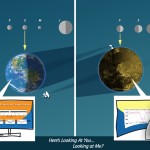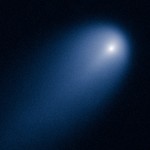W. M. Keck Observatory press release…
A team of scientists recently discovered a system of three planets, each just larger than Earth, orbiting a nearby star called EPIC 201367065. The three planets are 1.5-2 times the size of Earth. The outermost planet orbits on the edge of the so-called “habitable zone,” where the temperature may be just right for liquid water, believed necessary to support life, on the planet’s surface. The paper, “A Nearby M Star with Three Transiting Super-Earths Discovered by K2,” was submitted to the Astrophysical Journal today and is available here.

The planets were confirmed by the NASA Infrared Telescope Facility (IRTF) and the W. M. Keck Observatory in Hawaii as well as telescopes in California and Chile.
“Keck’s contribution to this discovery was vital,” said Andrew Howard, a University of Hawaii astronomer on the team. “The adaptive optics image from NIRC2 showed the star hosting these three planets is a single star, not a binary. It showed that the planets are real and not an artifact of some masquerading multi-star system.”
Due to the competitive state of planet finding, and the fact that time on the twin Keck telescopes are scheduled months in advance, the team asked UC Berkeley Astronomer, Imke de Pater to gather some data during her scheduled run.
Continue reading “Three Almost Earth-Size Planets Found Orbiting Nearby Star”

